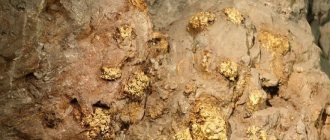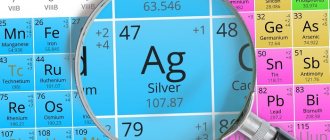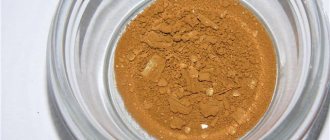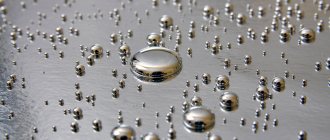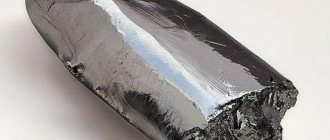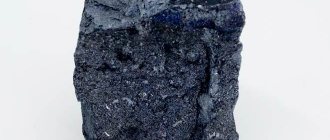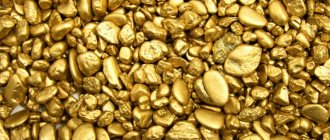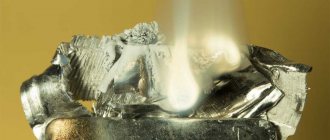| Gold | |
| Atomic number | 79 |
| Appearance of a simple substance | Soft malleable yellow metal |
| Properties of the atom | |
| Atomic mass (molar mass) | 196.96654 a. e.m. (/mol) |
| Atomic radius | 146 |
| Ionization energy (first electron) | 889.3 (9.22) kJ/mol () |
| Electronic configuration | [Xe] 4f14 5d10 6s1 |
| Chemical properties | |
| Covalent radius | 134 |
| Ion radius | (+3e) 85 (+1e) 137 |
| Electronegativity (Pauling) | 2,54 |
| Electrode potential | Au←Au-3 1.50 V Au←Au+ 1.70 V |
| Oxidation states | -3, 1 |
| Thermodynamic properties of a simple substance | |
| Density | 19,3 /³ |
| Molar heat capacity | 25.39[1]/(mol) |
| Thermal conductivity | 318 /(·) |
| Melting temperature | 1337,58 |
| Heat of Melting | 12.68 kJ/mol |
| Boiling temperature | 3080 |
| Heat of vaporization | ~340 kJ/mol |
| Molar volume | 10.2 ³/mol |
| Crystal lattice of a simple substance | |
| Lattice structure | cubic face-centered |
| Lattice parameters | 4,080 |
| c/a ratio | n/a |
| Debye temperature | 170,00 |
| Au | 79 |
| 196,96654 | |
| [Xe]4f145d106s1 | |
| Gold | |
Gold
- an element of a secondary subgroup of the first group, the sixth period of the periodic table of chemical elements, with atomic number 79. Denoted by the symbol Au (Latin Aurum).
The simple substance gold (CAS number: 7440-57-5) is a noble metal of yellow color. Diagram of a gold atom
Proto-Slavic *zolto (Russian gold, Ukrainian gold, Old Slavic gold, Polish złoto) is related to Lit. geltonas "yellow", Latvian. zelts "gold, golden"; with different vocalism: goth. gulþ, German Gold, English gold; further Skt. hiraṇyam, Avest. zaranya "gold", also Skt. hari "yellow, golden, greenish", from the Proto-Indo-European root *ǵʰel- "yellow, green, bright". Hence the names of the colors: yellow, green.
Connection with the root “sun” ( sol
, other Greek ἥλιος) is doubtful.
Properties of gold
Physical properties
Pure gold is a soft yellow metal. Some gold products, such as coins, get a reddish hue from admixtures of other metals, in particular copper. In thin films, gold shows through green. Gold has exceptionally high thermal conductivity and low electrical resistance. Gold is a very heavy metal: a ball of pure gold with a diameter of 46 mm has a mass of 1 kg. A liter bottle filled with gold sand weighs approximately 16 kg.
The heaviness of gold is a plus for its extraction. The simplest technological processes, such as washing at sluices, can provide a very high degree of gold recovery from the washed rock.
Gold is very malleable and malleable. From a piece of gold weighing one gram, you can stretch a wire three kilometers long or make gold foil 500 times thinner than a human hair (0.0001 mm). Through such a piece of foil, a ray of light shines through in a greenish color. The softness of pure gold is so great that it can be scratched with a fingernail. Therefore, in jewelry, gold is always alloyed with copper or silver. The composition of such alloys is expressed by breakdown, which indicates the number of parts by weight of gold in 1000 parts of the alloy (in Russian practice). The purity of chemically pure gold corresponds to 999.9 fineness - it is also called “bank” gold, since bars are made from such gold.
Chemical properties
Gold is the most inert metal, standing in the series of stresses to the right of all other metals; under normal conditions, it does not interact with most acids and does not form oxides, due to which it was classified as a noble metal, in contrast to ordinary metals, which are easily destroyed by the environment. Then the ability of aqua regia to dissolve gold was discovered, which shook confidence in its inertness.
The most stable oxidation state of gold in compounds is +3; in this oxidation state, it easily forms stable planar square complexes [AuX4]− with singly charged anions (F−, Cl−. CN−). Compounds with the oxidation state +1, which give linear complexes [AuX2]−, are also relatively stable. For a long time it was believed that +3 was the highest possible oxidation state of gold, however, using krypton difluoride, it was possible to obtain Au+5 compounds (AuF5 fluoride, salts of the [AuF6]− complex). Gold(V) compounds are stable only with fluorine and are strong oxidizing agents.
The oxidation state +2 is not typical for gold; in substances in which it is formally equal to 2, half of the gold is usually oxidized to +1, and half to +3, for example, the correct ionic formula of gold(II) sulfate AuSO4 is not Au2+ (SO4)2−, and Au1+Au3+(SO4)2−2. Recently, complexes have been discovered in which gold still has an oxidation state of +2.
Of the pure acids, gold dissolves only in hot concentrated selenic acid:
2Au + 6H2SeO4 = Au2(SeO4)3 + 3H2SeO3 + 3H2O
Gold reacts relatively easily with oxygen and other oxidizing agents with the participation of complexing agents. Thus, in aqueous solutions of cyanides with access to oxygen, gold dissolves, forming cyanoaurates:
4Au + 8CN− + 2H2O + O2 → 4[Au(CN)2]− + 4 OH−
In the case of a reaction with chlorine, the possibility of complex formation also significantly facilitates the reaction: if gold reacts with dry chlorine at ~200 °C to form gold(III) chloride, then in a concentrated aqueous solution of hydrochloric and nitric acids (regia vodka) gold dissolves to form chloraurate -ion already at room temperature:
2Au + 3Cl2 + 2Cl− → 2[AuCl4]−
Gold easily reacts with liquid bromine and its solutions in water and organic solvents, giving tribromide AuBr3.
Gold reacts with fluorine in the temperature range 300−400; at lower temperatures the reaction does not occur, and at higher temperatures gold fluorides decompose.
Gold also dissolves in mercury, effectively forming a low-melting alloy (amalgam).
Physiological effects
Some gold compounds are toxic and accumulate in the kidneys, liver, spleen and hypothalamus, which can lead to organic diseases and dermatitis, stomatitis, thrombocytopenia.
Ductility
It is difficult to say which basic property of gold is most important to us, but we can definitely say that malleability is one of the main ones. Thanks to it, this metal can be turned into a thin sheet. So, from 1 g of gold you can get a plate of thin foil, the area of which will be 1 square. m. This allows it to be used in various fields of human activity. Gold is a metal that can be made translucent and very thin, but it will not lose its beauty and shine. Thanks to this property, it became possible to obtain thin-sheet (leaf) material, which is used to cover the domes of churches and decorate the interior of premises.
Geochemistry of gold
The gold content in the earth's crust is very low - 3 μg / kg, but deposits and areas sharply enriched in the metal are very numerous. Gold is also found in water. 1 liter of both sea and river water carries approximately 4*10−9 g of gold.
Gold is characterized by its native form. Among its other forms, it is worth noting electrum, an alloy of gold and silver, which has a greenish tint and is relatively easily destroyed when transferred by water. In rocks, gold is usually dispersed at the atomic level. In deposits it is often enclosed in sulfides and arsenides.
There are primary deposits of gold, placers into which it falls as a result of the destruction of ore deposits, and deposits with complex ores in which gold is extracted as an associated component.
Alloys
This precious metal has the ability to combine well with other chemical elements. In this case, the final product will have different physical characteristics. Jewelry yellow gold is most often an alloy of several metals, in which the content of the substance in question is sometimes less than 40%. Moreover, various impurities and their specific gravity in its composition directly affect the shade of the final product. So, you can find several types of jewelry gold on sale:
- White - with palladium, nickel and platinum. It is most often used to create products with precious stones.
- Yellow - with copper, silver, nickel. The proportion of impurities in it can vary from 4 to 50%.
- Red - with copper, silver. The specific gravity of impurities in such alloys reaches 62.5%.
- Pink - with palladium, copper, silver. It contains impurities exceeding 60%.
The quality and cost of a gram of gold depend entirely on its purity and the presence of certain impurities.
Gold mining
People have been mining gold since time immemorial. Humanity encountered gold already in the 5th millennium BC. e. in the Neolithic era due to its distribution in a native state.
According to archaeologists, systematic mining began in the Middle East, from where gold jewelry was supplied, in particular, to Egypt. It was in Egypt, in the tomb of Queen Zer and one of the queens Pu-abi Ur in the Sumerian civilization, that the first gold jewelry dating back to the 3rd millennium BC was found. e.
In Russia, it is generally accepted that gold mining began on May 21 (June 1), 1745, when Erofey Markov, who found gold in the Urals, announced his discovery in the Office of the Main Board of the factories in Yekaterinburg.
Throughout history, humanity has mined about 140 thousand tons of gold.
In 2007, 2,380 tons of gold were mined, and in 2008 - 2,330 tons. The leaders in production were: China (mined 275 tons in 2007, and 295 tons in 2008), South Africa (252/250), USA (238 /230), Australia (246/225), Peru (170/175), Russia (157/165), Canada (101/100), Indonesia (118/90), Uzbekistan (85/85), Ghana (84/ 84), Papua New Guinea (65/65), Chile (42/42), Mexico (39/41), Brazil (40/40).
There are about 16 gold mining companies in Russia. The leader in gold mining in Russia is the Polyus Gold company, which accounts for about 20% of the market. The largest amount of gold is mined in the Chukotka Autonomous Okrug, Krasnoyarsk Territory and Amur Region. [3]
The world's explored gold reserves are estimated at 100 thousand tons.
Flexibility (ductility)
This is one of the most important features that gold has. The properties of metal allow it to be crushed, squeezed, bent, and compressed. Due to its ductility, gold can take different shapes without breaking. From 1 g you can draw the thinnest wire (thread), the length of which will be 2610 m. Its diameter will be only 2 * 10-6 mm, which allows the thread to be used in the modern electronics industry with microchips. The tensile strength of annealed gold is 100-140 MPa.
Receipt
Gold nugget
To obtain gold, its basic physical and chemical properties are used: its presence in nature in a native state, the ability to react with only a few substances (mercury, cyanide). With the development of modern technologies, chemical methods are becoming more popular.
Flushing
The washing method is based on the high density of gold, due to which, in a stream of water, minerals with a density less than gold (and these are almost all minerals of the earth’s crust) are washed away and the metal is concentrated in a heavy fraction, sand consisting of minerals of high density, which is called concentrate. This process is called concentrate washing or grinding. In small volumes it can be done manually using a washing tray. This method has been used since ancient times, and is still used to develop small placer deposits by prospectors, but its main application is to search for deposits of gold, diamonds and other valuable metals.
Flushing is used to develop large placer deposits, but special technical devices are used: dredges and flushing devices. The resulting concentrates, in addition to gold, contain many other dense minerals and the metal is extracted from them, for example, by amalgamation.
All placer gold deposits are developed using the washing method; it is used to a limited extent in primary deposits. To do this, the rock is crushed and then washed. This method cannot be applied to deposits with dispersed gold, where it is so dispersed in the rock that after crushing it does not separate into individual grains and is washed away during washing along with other minerals. Unfortunately, during washing, not only small gold is lost, which is easily washed off from the washing block, but also large nuggets, the hydraulic coarseness of which does not allow them to settle quietly in the cells of the mat. Therefore, on dredges and industrial equipment, be sure to keep an eye out for large rolling debris - these could very well turn out to be nuggets!
This method of extracting gold was historically the first, and it is very cheap because it does not require the construction of expensive factories, and in the case of river sediments, there is no need to crush the rock. It is economically profitable to mine placers with a gold content of more than 0.1 g per 1 cubic meter of loose rock (sand, loam, etc.).
Amalgamation
The amalgamation method is based on the ability of mercury to form alloys - amalgams with various metals, including gold. In this method, moistened crushed rock was mixed with mercury and subjected to additional grinding in mills - running bowls. The amalgam of gold (and associated metals) was removed from the resulting sludge by washing, after which the mercury was distilled from the collected amalgam and reused. The amalgamation method has been known since the 1st century BC. e., acquired the greatest scale in the American colonies of Spain starting from the 16th century: this became possible due to the presence in Spain of a huge mercury deposit - Almaden. At a later time, the method of external amalgamation was used, when crushed gold-bearing rock, during washing, was passed through enrichment sluices lined with copper sheets coated with a thin layer of mercury. The amalgamation method is applicable only in deposits with a high gold content or during its enrichment. It is now used very rarely, mainly by prospectors in Africa and South America.
Cyanidation
Gold dissolves in solutions of hydrocyanic acid and its salts, and this property has given rise to a number of extraction methods by cyanidation of ores.
The cyanidation method is based on the reaction of gold with cyanides in the presence of atmospheric oxygen: crushed gold-bearing rock is treated with a dilute (0.3-0.03%) solution of sodium cyanide, gold from the resulting solution of sodium cyanoaurate Na[Au(CN)2]
deposited either with zinc dust or on special ion exchange resins.
The cyanidation method was initially used in large factories, where the rock was crushed and cyanidation was carried out in special vats. However, the development of technology has led to the emergence of the heap leaching method, which consists of the following: a waterproof platform is prepared, ore is poured onto it and it is irrigated with cyanide solutions, which, seeping through the rock, dissolve the gold. After this, they enter special sorption columns, in which the gold is deposited, and the regenerated solution is sent back to the heap.
The cyanidation method is limited by the mineral composition of the ores; it is not applicable if the ore contains large amounts of sulfides or arsenides, since cyanides react with these minerals. Therefore, cyanidation processes low-sulfide ores or ores from an oxidation zone in which sulfides and arsenides are oxidized by atmospheric oxygen.
Complex multi-stage technologies are used to extract gold from sulfide ores. Gold extracted from deposits contains various impurities, so it is subjected to special highly purified processes that are carried out in refineries.
Regeneration
It is carried out by the action of a 10% alkali solution on solutions of gold salts, followed by the precipitation of refined gold onto aluminum from a hot hydroxide solution.
History of metal
The news of the first gold nugget found dates back to the Neolithic period. Then the rock was used in the manufacture of dishes and various household items. The metal was common in Ancient Egypt, Rome, China and India. In those days, gold was called the king of all metals. Ancient people believed that the yellow material had healing and magical properties; it was a symbol of the sun. Later it began to be used as a means of payment. Gold emphasized the high status of the owner, but it was also dangerous: people were ready to do anything to take possession of an attractive and precious material.
The first civilizations in Central Europe, South America and North Africa mined gold by hand. Several nuggets weighing 8-10 g could be obtained in only 2-3 days. Since the mineral could not be purified from impurities, at that time it had a low standard. During late antiquity, alchemy began to gain popularity. People have learned to transform base substances into noble ones. Although alchemy has not achieved great success, thanks to it there are modern technologies that make it possible to extract gold from ore and purify it from impurities.
Some people are interested in why, when discovering metal, scientists gave such a name to a chemical element. “Gold” is related to the symbols for the sun in various languages. The name of the element Aurum is translated from Latin as “yellow”. The word is related to Aurora, the goddess of the dawn. In the Slavic language, “yellow” sounded like “zelto,” which is close to gold.
Application
The gold currently available in the world is distributed as follows: about 10% is in industrial products, the rest is divided approximately equally between centralized reserves (mainly in the form of standard bars of chemically pure gold), private property in the form of bars and jewelry.
As an investment object
Gold is the most important element of the global financial system, since this metal is not subject to corrosion, has many technical applications, and its reserves are small. Gold was practically not lost during historical cataclysms, but was only accumulated and melted down. Currently, the world's bank reserves of gold are estimated at 32 thousand tons (if you fuse all this gold together, you will get a cube with a side of only 12 m).
Gold has long been used by many peoples as money. Gold coins are the best-preserved antiquities. However, it only became established as a monopoly monetary commodity in the 19th century. Until World War I, all world currencies were based on the gold standard (the period 1870–1914 is called the “golden age”). At this time, paper bills served as proof of the presence of gold. They were freely exchanged for gold.
In industry
In terms of its chemical resistance and mechanical strength, gold is inferior to most platinum group metals, but is irreplaceable as a material for electrical contacts. Therefore, in microelectronics, gold conductors and gold electroplating of contact surfaces, connectors, and printed circuit boards are used very widely.
Gold is used as a target in nuclear research, as a coating for mirrors operating in the far infrared range, and as a special shell in a neutron bomb.
Gold solders wet various metal surfaces very well and are used in metal soldering. Thin gaskets made from soft gold alloys are used in ultra-high vacuum technology.
Gilding of metals (in ancient times it was exclusively an amalgam method, nowadays it is mainly galvanic) is widely used as a method of protection against corrosion. Although this coating of base metals has significant disadvantages (softness of the coating, high potential for pitting), it is also common due to the fact that the finished product takes on a very expensive, “golden” appearance.
Gold is registered as a food additive E175.
In jewelry
Gold items.
Gold medal received by the artist G.N. Gorelov in 1909 at the International Exhibition in Munich for the painting “Mockery of Heretics” and the gold wedding rings of the spouses G.N. Gorelov and T.N. Gorelova. The traditional and largest consumer of gold is the jewelry industry. Jewelry is made not from pure gold, but from its alloys with other metals, which are significantly superior to gold in mechanical strength and durability. Currently, Au- alloys are used for this, which may contain additives of zinc, nickel, cobalt, and palladium. The corrosion resistance of such alloys is determined mainly by their gold content, and the color shades and mechanical properties are determined by the ratio of silver and copper.
The most important characteristic of jewelry is its fineness, which characterizes the gold content in it.
In dentistry
Dentistry consumes significant amounts of gold: crowns and dentures are made from alloys of gold with silver, copper, nickel, platinum, and zinc. Such alloys combine corrosion resistance with high mechanical properties.
In pharmacology
Gold compounds are included in some medications used to treat a number of diseases (tuberculosis, rheumatoid arthritis, etc.). Radioactive gold is used in the treatment of malignant tumors
Reflective Features
Gold, whose properties and uses are determined by its chemical composition, is easily polished. It has significant reflectivity. Very thin sheets of gold are able to transmit the sun's rays. Amazingly, they will not heat up at all, since the thermal (infrared) part of them will be reflected from such plates. Thanks to this property, gold has found application in construction. It is used for tinting glass in countries with hot climates. Thanks to this solution, the energy required for air conditioning the premises is significantly saved. The reflective properties of gold are even used in astronautics. It is applied to protective helmets and other surfaces of space equipment to reflect the significant flux of infrared rays in space.
Gold prices
Gold prices after the US gold default
In 1792 in the USA it was established that 1 ounce of gold would cost $19.3. In 1834, the price per ounce was already $20.67, since the United States did not have sufficient gold reserves to cover the entire volume of issued money, and the exchange rate had to be reduced.
After World War I, devaluation continued. In 1934, 1 ounce of gold cost $35. Despite the economic crisis, the United States tried to maintain a fixed peg of the dollar to gold, for the sake of this the discount rate was raised, but this did not help. However, due to the subsequent wars, gold began to move from the Old World to the New, which temporarily restored the dollar's peg to gold.
In 1944, the Bretton Woods Agreement was adopted. A gold exchange standard was introduced, based on gold and two currencies - the US dollar and the British pound sterling, which put an end to the monopoly of the gold standard. According to the new rules, the dollar became the only currency directly linked to gold. The US Treasury agreed to exchange dollars for gold to foreign government agencies and central banks at a rate of $35 per troy ounce. In fact, gold has turned from the main to a reserve currency.
In the late 1960s, high inflation in the United States again made it impossible to maintain the gold peg at the same level, and the situation was complicated by the US foreign trade deficit. The market price of gold began to significantly exceed the officially established one. In 1971 the gold content of the dollar was reduced to $38 per ounce, and in 1973 to $42.22 per ounce. In 1971, US President Richard Nixon abolished the dollar's peg to gold, although this step was officially confirmed only in 1976, when the so-called Jamaican floating exchange rate system was created. This meant that the dollar was no longer backed by anything other than US debt.
Gold prices adjusted for inflation
After this, gold became a special investment product. Investors have relied exclusively on gold for many years. By the end of 1974, gold prices jumped to $195 per ounce, and by 1978 to $200 per ounce. By the beginning of 1980, the price of gold reached a record high of $850 per ounce (over 2000 in 2008 prices), after which it began to gradually fall. At the end of 1987 it was about $500 per ounce. The fastest decline occurred in 1996-1999, when the price of gold fell from $420 to $260 per ounce.
Be that as it may, the fall stopped and the price of gold began to rise again due to the agreement of leading central banks to limit gold sales in 1999. By the end of 2006, the price per ounce of gold reached $620, and by the end of 2007 it was already about $800. At the beginning of 2008, the price of gold exceeded $1,000 per ounce. However, at comparable prices, gold has not reached its 80s peak of above $2,000. In mid-October 2009, the price of gold fluctuated between $1,060 and $1,070 per troy ounce.[4]
Gold for investment comes in several forms - gold bars, gold coins, gold sand. Investment coins are the best way to invest in the Russian Federation: the buyer does not pay VAT. However, the price for 1 gram of gold in coins in Russia exceeds the price of 1 gram in bullion, even taking into account VAT and interest on the latter’s spread (for example, in Sberbank of the Russian Federation). Unlike E-bay auctions, where the cost clearly correlates with the world price. Gold in Uncirculated coins (the name of the mintage for investment coins) can cost 20-30% more than gold in 50 or 100 gram bars, even taking into account the fact that 18% VAT and so-called “spread” percentages are paid to the bank for gold bars (about 2% for the bank’s purchase of gold and 2% for its sale to you, that is, a total of about 4% in addition to VAT).
In addition, the dynamics of gold prices is a critical economic indicator, allowing one to assess investors' appetite for risk. You can often observe that the price of gold and stock indices move in antiphase, since during periods of unstable economic conditions investors prefer conservative assets that are protected from complete depreciation. Conversely, when expectations for economic growth become more optimistic, appetite for higher yields grows, causing the yellow metal's quotes to decline.
Level of international reserves
International reserves of the world's countries in 2006
| States with the largest international reserves. | $1953 (March 2009) | |
| 2 | Japan | $1042.34 (August 2009) |
| — | Eurozone | $531 (February 2009) |
| 3 | Russia | $413 (July 2009) |
| 4 | Republic of China | $305 (April 2009) |
| 5 | India | $256 (May 2009) |
| 6 | The Republic of Korea | $212 (April 2009) |
| 7 | Brazil | $203 (March 2009) |
| 8 | Hong Kong | $186 (March 2009) |
| 9 | Singapore | $166 (March 2009) |
| 10 | Germany | $144 (February 2009) |
These ten countries contain more than 50 percent of the world's total international reserves.
Electrical conductivity
Using this property of gold allows it to be used in the electronics industry. This metal has high electrical conductivity. At the same time, it is resistant to oxidation. The electrical conductivity of gold relative to copper is 75%. Resistance at 0ºC - 2.065 * 10-8 Ohm. This main property of gold allows it to be used in the production of such complex electronic devices as mobile phones, televisions, computing equipment, calculators, and computers. The thermal conductivity of the noble metal at 0ºC is 311.48 W/(mK).
Measures of gold purity
British carat system
Traditionally, the purity of gold is measured in British carats. 1 British carat is equal to one twenty-fourth of the weight of the alloy. 24 carat gold (24K) is pure, without any impurities.
To change the quality characteristics of gold, alloys with various impurities are made for various purposes (for example, to increase hardness). For example, 18 karat gold (18K) means the alloy contains 18 parts gold and 6 parts impurities.
Russian sample system
The system adopted in Russia differs from the British one and is similar to that adopted in Germany. In Russia, the purity of gold is measured by its fineness.
The fineness ranges from 0 to 1000 and shows the gold content in parts per thousand. Thus, 18-karat gold corresponds to 750 purity. Gold of 999.96 purity is considered “virtually pure”; this is exactly the purity it comes in bars. Gold of 999.99 purity is extremely expensive to obtain and is used only in chemistry. In the domestic jewelry industry, jewelry is made from 375, 500, 585, 750, 900, 916 and 958 gold. At the request of an individual, the assay office can supply a 583 sample, although in many countries of the former USSR they abandoned the 583 sample and left 585, for example in Latvia.
How to spot a fake
To make money by passing off products made from base alloys as valuable, scammers resort to tricks: burning silver on fire, combining copper with zinc and tin. Pay attention to:
- Brand - it must meet the standard.
- Price - if it is incredibly low, this is an alarming sign.
- Country of origin - check the jewelry again if it is Turkey, China or the UAE.
There are tips to try something on your teeth in front of the seller or test it chemically by dropping iodine on it. These are effective methods for determining the authenticity of high standards, but they are not always acceptable in society. If the seller makes you doubt so much that you are ready to bite his goods, you should refuse the purchase.
